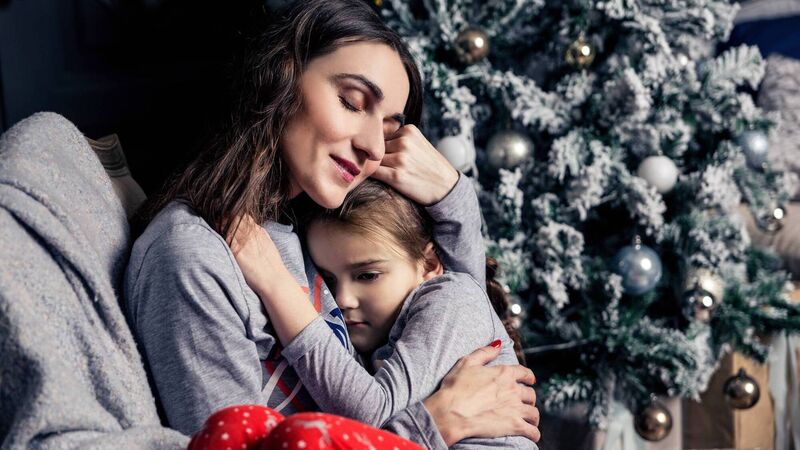Christmas is often presented as a season of joy, connection, and togetherness. However, for many families, especially for children and young people living with grief, the festive spirit can feel painfully out of sync with their inner experience.
Grief doesn’t pause for Christmas. If anything, the contrast between the festive atmosphere and a young person’s internal reality can make this time of year especially distressing.
Parents often ask me what they should say to young people who are grieving, and wonder if they’re “getting it right”. But supporting a grieving child isn’t about perfection; it’s about presence.
Young people don’t expect us to have all the answers. What they’re looking for is someone who will stay steady while they feel unsteady. Someone who won’t shy away from the difficult bits and will name what’s happening rather than trying to pretend it isn’t.
One of the biggest misconceptions about children’s grief is that it manifests in the same way as in adults. It rarely does. Children tend to have rapid fluctuations between sadness and normalcy. They might be tearful and upset, yet they can be jumping on the trampoline 10 minutes later. This doesn’t mean they’re “fine” or “resilient”. It just means they’re coping in small, manageable pieces. For them, grief is like turning a tap on and off. When it becomes overwhelming, they instinctively step away.
Research consistently shows that children grieve differently from adults. For example, a 2022 study in Development and Psychopathology noted that children’s grief is shaped by their stage of development and can look very different depending on their age. Younger children may swing rapidly between distress and play, while older children and teenagers often show their grief through anxiety, irritability, or withdrawal.
Younger children might not understand that death is permanent. They may ask the same questions repeatedly, such as “When is mam coming back?” or “Can we visit grandad in heaven?” This isn’t because they forget or don’t understand, but because repetition helps them process difficult information.
While older children understand that death is final, they often get caught up in the emotional aftermath. They might worry that someone else will die or blame themselves for things they said or didn’t say. They might also become more irritable or clingy than usual, or unusually quiet.
Teenagers, although more cognitively mature, often conceal the emotional regulation of a younger child behind the facade of a young adult. They may shut down, act out, or attempt to take on the role of the “strong one”.
They can also feel out of step with their peers and sometimes resent the expectation that life continues as usual.
Grief fluctuates in intensity at all ages. It comes in waves, and these waves can be especially overwhelming during a season deeply embedded in routine, tradition, and memory.
An extensive longitudinal study published in 2024 identified several grief “trajectories”, including groups of children whose grief remained strong for years and others whose emotions rose and fell over time. These findings echo what many families notice: Grief doesn’t disappear, but shifts, softens, and resurfaces — especially around meaningful times like Christmas.
Enduring memories
The rituals of Christmas are rich with sensory cues: The song that was someone’s favourite, the decorations they always displayed, the seat they always occupied during dinner. These seemingly small details can trigger poignant reminders that someone important is missing.
Children feel this deeply, and so they might miss the person who filled a particular Christmas role — such as decorating the tree or taking them to see Santa and, as a result, struggle with traditions that seem incomplete. They can also feel guilty for enjoying themselves or worry that they are the only ones who are not excited.
This is not helped by the fact that Christmas is often marketed as a time of picture-perfect happiness, and children can feel that their sadness doesn’t belong or isn’t allowed. That mismatch can intensify their sense of isolation.
Yet this painful mismatch can present an opportunity to teach children about the most complex aspect of loss: That grief and joy can exist together, and that we can feel both sadness and celebration at the same time.
Supporting a grieving child at Christmas isn’t about finding the perfect strategy. It’s about showing up.
At Christmas, questions can surface like “Are we still going to do what dad used to do?”, “Why does Christmas feel different now?”, and “Is it OK to have fun?”. It’s key to reassure the child that they can ask you anything. Don’t worry if you don’t know the answer; all they need to know is that you will figure it out together.
Children often absorb what adults model. If we hastily reassure them by saying things like, “Don’t be sad, we’ll still have a lovely day”, what they may hear is, “Your sadness is a problem”. Instead, try to normalise their emotional experience by saying things like, “Many people find Christmas tough after someone dies”, or “It’s OK to miss them and still enjoy parts of the day”.
Remember, the goal is not to remove the sadness but to accompany it.
When grief disrupts a child’s sense of safety, predictability helps rebuild it. So perhaps keep the parts of Christmas that feel comforting, and gently adjust the ones that feel too painful. Try to build in downtime, rather than packing the schedule and reassure yourself that plans can change if they need to — people will understand. In situations like these, your flexibility becomes a form of care.
While many don’t want the Christmas period to be a constant memorial, it is crucial to recognise children often fear forgetting the loved one who has died. Small rituals can help anchor their memory and give the child a sense of connection. Simple gestures —like lighting a candle, hanging a special ornament, or writing a memory on a card and putting it on the tree — can be enough to acknowledge loss without labouring it.
The most critical part of helping a child through grief is choice. Some children will want to participate in these rituals; some won’t. You need to accept that there is no right way to honour their memory.
Grief doesn’t always announce itself politely. It can show up during a carol, on Christmas morning, or when opening a gift. Preparing children for this doesn’t cause distress; it reduces it. It can be helpful to remind them that sometimes grief comes out of nowhere. Reassure them that if that happens, they can come to you and take a break together.
Also discuss the expected moments, such as who used to do what, for example, if dad traditionally went to pick the tree, or mam usually put up the decorations. Consider how these traditions might look different this year and the options the family has for managing these changes. It is often best to reach a consensus on what to do instead of making unilateral decisions.
While you may think you don’t want to burden children with these decisions, and they may not have much to contribute, in my experience, they usually value being asked.
Healthy grieving
Children are far better emotional barometers than we give them credit for. They often expertly pick up the “temperature” of the household long before anything is said. But this doesn’t mean you must hide your feelings. In fact, being appropriately open can be helpful because it models healthy grieving.
Give yourself permission to say things like “I’m feeling sad today because I miss him. It’s OK for both of us to feel like this”. What children need to know is that although you’re sad, you’re still steady and you can and will move on from it.
Remember, supporting yourself is supporting your child. Whether it’s through friends or counselling, you should use whatever supports you need to manage.
Most children, given time and care, will find their way through grief. Some may need extra support. Look out for things like persistent withdrawal, significant behavioural changes that are persistent, overwhelming anxiety, prolonged sleep or eating difficulties, ongoing guilt or hopelessness, or risk-taking behaviours.
Reaching out for help for your child following a loss is not an indication that you have failed. It’s an indication that you’re doing exactly what your child needs.
Christmas after the death of a close family member won’t ever be quite the same. But that doesn’t mean it can’t contain moments of connection, warmth, or even joy. Children can sometimes cope with far more than we give them credit for, especially when they’re supported with honesty, empathy, and presence.
Grief doesn’t replace joy; it reshapes it. And when families face that reshaping together, with an approach of gentleness, flexibility, and openness, then Christmas can hopefully become less about what’s missing and more about what love remains.
- Colman Noctor is a child psychotherapist


CONNECT WITH US TODAY
Be the first to know the latest news and updates











